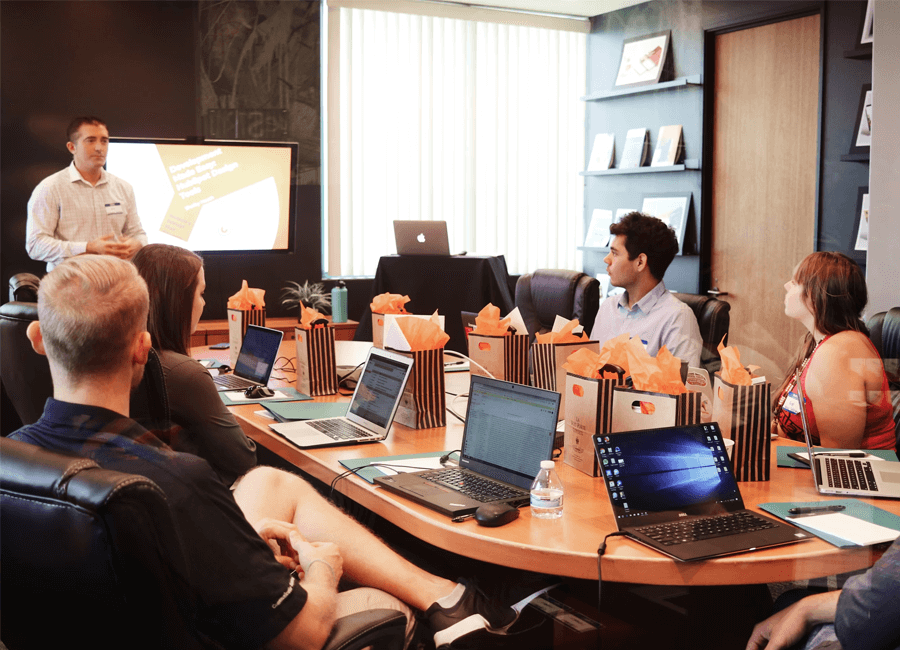Qualitative research is one side of the data and insights coin. The side obsessed with stories, detail and exploration. In recent years the qualitative side of market research has grown significantly due to the large amount of innovation dedicated to it, and from this growth has sprung many new methodologies, tactics and tools to help insight teams and stakeholders get the most out of this research experience.
But from this growth and heightened demand for qualitative insights has come a need for more innovation to occur, but this time specifically to the scaling and agility of qualitative research. How exactly can the insights industry create sustainable scaled qualitative research experiences in the face of numerous resource and time-based challenges?
FlexMR’s Research Director, Maria Twigge, hosted seven insight professionals from a variety of industries to an online roundtable event to discuss this very topic on 4th May 2022, the attendees were:
- Anna Apostolopoulos, Director of Insights in the English Language Learning Division at Pearson
- Nick Clay, Head of Research for National Residential Landlords Association
- Amrita Bose, Senior Research Analyst at Healthwatch England
- Gillian Monk, Senior Research Analyst at Healthwatch England
- Will Howard, Senior Research Analyst at Healthwatch England
- Yuka Uchijima, Head of Research and insights at Ogilvy
- Dr Katharine Johnson, Client Success Manager at FlexMR
A big thanks to all of roundtable attendees, everyone contributed valuable experience-based insights about their use and views of qualitative research. Scaling qualitative research and generating qual insights in an agile manner is a tricky topic to talk about with the different challenges insight experts face every day, but there were many fantastic points made and collaborative discussions had at this roundtable event.
| Tweet This | |
| One side of the research coin, qualitative research has grown in both demand and capability in recent years. But how do insight teams scale qual sustainably? |
For What Do We Use Qual Research?
Maria started off the event by asking what are the typical uses of qualitative research? She mentions that “we need to immerse ourselves in the meaning of research topic to see the world from the perspective of research audiences in order to make the right decisions that benefit those audiences and allow us to succeed.” While this is a popular response to the initial question, the other roundtable attendees had a lot more to say.
One attendee added that there are lots of “complex areas and experiences to explore when it comes to consumer behaviour and lives, and while we can use quantitative research to a degree but when trying to get to root cause then it’s qualitative research really gives that depth.”
There was a consensus with this sentiment, with another attendee mentioning that qualitative research is “seen as nice to have, therefore it’s common to cut the amount of qualitative research down or event out. If we’re looking to really understand the language someone is using and to improve communications then nothing beats immersing yourself in that language. Sometimes we encounter a very niche topic, where there aren’t enough respondents to provide a significant amount of data, but there are still valuable experiences to learn from."
"Qualitative data comes in useful to highlight issues and opportunities to improve, where quantitative data is limited when the sample is scarce.”
Qualitative research is key to successful decision-making. The attendees noted that qualitative research can be used to explore new areas without any assumptions and try to take stakeholders on a journey. Qualitative research adds richness and depth that we otherwise wouldn’t get; verbatim comments are powerful and help connect stakeholders to the research audience, and the more closely connected stakeholders are to their customers then the more powerful the insights will be.
How Do Organisations Feel about Qual?
Maria then moved onto how our attendees' organisations felt about qualitative insights. This sparked the acknowledgement that stakeholder organisations view aspects of market research differently to insight professionals, and in terms of qualitative research stakeholders seemed to want to try to get quantitative insights from qualitative data.
One attendee stated that sometimes they need to say “hello I’m here!”. Where their stakeholders typically want to do a survey but actually don’t need to do it, it’s the insight team’s job to make sure they know that it would be a waste of time doing quantitative research when qualitative would give them better results. While it is a mark of success that stakeholders come to the insight team to do surveys, then insight experts have to explain that different projects warrant different approaches and surveys are not always the right choice.
Another attendee mentioned that they do a lot of different types of quant and qual, used to show planners and creatives and other stakeholders different views on the brand or different aspects of the customer experience. They mentioned that “a lot of stakeholders are immersed in own brand world, particularly through quantitative data, and they see world through segmentations, so often our role in qualitative research is to show them the realities and different perspectives of their research audiences.”
Scaling Qualitative Research and Insights
Once they gained a foundational understanding about what they knew qualitative research was to each other and what it meant to the organisations they were in, the question then moved onto: what does scaling qualitative research actually mean?
Now the most commonly understood answer was provided to us by Maria, who mentioned that scaling qualitative research typically means increasing the sample size to foster more confidence in results. This deals with the challenge most faced by qualitative researchers, with criticisms centred on the low amount of people in the sample: “you’ve only spoken to six people!” This criticism tends to result in stakeholders taking on insights or not putting too much stock in them.
But in this discussion, we found a few more definitions that really help to better understand the scaling pressures faced by insight teams today. The second definition focussed on increasing the frequency of qualitative research projects and tasks to capture the true nature of customer behaviour/habit change; scaling the number of times we check in with research audiences to map behaviours relevant to the brand or customer experience.
In this definition it was pointed out that we should also think about seasonality and holidays and how that impacts the customer behaviours, brand experience, and sector. And along the same lines, geographic considerations are crucial too, so can we scale the number of customers we get from different locations to create a robust dataset?
Now of course there are challenges to take into account that also help define another version of ‘scaling qual’. We need to consider the ambition when we attempt to scale qualitative research, as sometimes the need to scale can get a bit out of hand for the resources and budget allocated to insight teams. Because of the time, budget and resource constraints facing insight teams and stakeholders today, we can use secondary data and projects to scale the amount of qualitative data and insights needed for the insight team’s qualitative project.
This solution was presented by one attendee who talked about “using other companies and other reports to loop in with your work to try and see similarities and use that for support your findings.” Doing this background research before conducting your own means you can find something similar to fortify your own work, and that’s one way of scaling qualitative research up.
| Tweet This | |
| There are many benefits to qual research that stakeholders are now coveting, but there are challenges to scaling qualitative research that insight experts need to understand. |
Challenges to Scaling Qualitative Research
When talking about scaling up qualitative research, one attendee rightly pointed out that they always ask: what’s purpose of scaling up?
Interviewing lots of people for no purpose is just interviewing it for the sake of it. If insight teams interview 50% of people stakeholders ask them to, they will likely end up having just as good data and also more time for analysis or more time to do more research based on first set of insights. Because stakeholders have been used to quantitative research and data based off talking to hundreds of people, we need to educate them into understanding that speaking to more people isn’t necessarily better.
There is a danger that scaling up qualitative research is where qual turns into quant. Insight teams are pressured to deliver quantitative results from qualitative data. Insight teams need to communicate that the intention of qualitative research is to provide understanding not lots of data; it captures full scope of whatever it is we’re exploring.
Another challenge when wanting to scale up qualitative research is the perception and biases of stakeholders themselves. One attendee mentioned that they’ve encountered a few times when stakeholders go to a focus group and hear one opinion that agrees with their views and decisions then they’ll just lock onto that. Scaling up qualitative research when stakeholders lock onto one view means that scaling up wasn't worth the time, cost and effort.
One of the biggest challenges to scaling qualitative research is doing things in-person, such as focus groups and face-to-face interviews. It’s hard to scale offline qualitative research up with a limited task force and the other traditional challenges that offline qualitative research has (i.e. geographic limitations, more funds dedicated to covering respondent travel costs and incentives, having to outsource research to agencies for respondents in multiple countries, and factoring in the cost when respondents don’t turn up). Online qualitative research helps insight teams be cost-effective and bring the research audiences to life no matter where they reside.
One crucial challenge to scaling up online qualitative research in particular is that of low digital users. One attendee brought up the fact that a lot of people are still excluded from online research because they don’t have access to the technology needed to participate – people might not have access to the internet or digital devices due to the cost or means to get them or they might not understand how to use technology if they do have it, so how do we include these respondents? How do we scale qualitative research when it includes these participants?
And lastly, do we lose agility when scaling up qual? The typical consideration to agile qualitative research that a couple of attendees pointed out is: can we get the right people in a room quickly enough? It’s really hard to do well. Having a pre-built research community that is already recruited and engaged in the research helps, but it’s still difficult to get commitment from research respondents.
There are benefits to using online research techniques to deliver qualitative research at scale. Maria used InsightHub as an example as it hosts the technology to capture and transcribe videos, facilitating close to face-to-face interactions negating the typical challenges to in-person research, but what else in terms of technology could we be using to scale qual in an agile way?
"If you’ve built the panel and have respondents there and engaged already then you can turn things around exceedingly quickly. You can react and redirect or explore more insights in detail depending on relevance. That’s agility. "
There was more discussion prompted by this as one attendee asked, has the first attendee felt more success doing agile qual research online vs. In-person focus groups? The resulting response was that it “really depends on subject matter, complexity and people. [They are] able to do a lot more research than before.
While there are some aspects of in-person focus groups that are missed when using a different qualitative methodology online such as question boards, but if respondents are invited to a three-day event then they can dip in and out at their own convenience. The respondents are more flexible as well, responding to comments and having discussions over time rather than it all being concentrated in the moment.”
The missing quality of text-based online qualitative research methods can be made up by using video. But this then begs the question, are we using video enough in market research?
The main benefit our attendees mentioned to using video for both data collection and analysis, as well as insights activation, was putting a face to the subject matter at hand. One attendee mentioned that a single 90-second video case study is more powerful than reading raw numbers in a booklet report, the video brings consumers and insights to life and influence policy and change direction. Customers and consumers have the chance to passionately tell researchers and stakeholders what matters to them, and stakeholders have a duty to listen to video and get it to right person in organisation.
Most of this discussion focussed on video replacing in-person focus groups, but what about video to record daily lives, routine tasks, in-the-moment insights from experiences and such? Video can be used a lot more than just with respondents sitting in front of a camera. One attendee mentioned a technique used by their company where they had participants run through an online experience recording their every in-the-moment reactions and frustrations. They had one research participant tutting consistently as an automatic reaction and this one video brought frustration to life for both researchers and stakeholders, it actually became famous throughout the organisation, shown over and over again. This one video had stakeholders everywhere thinking again about how annoying it is to interact with them as a company. This delivers impact and shows what we need to change.


















